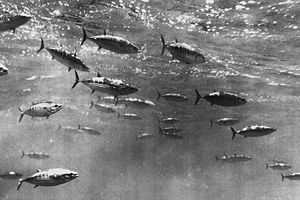Tuna
Tuna are several species of ocean-dwelling fish in the family Scombridae, mostly in the genus Thunnus. Tunas are fast swimmers—have been clocked at 77 km/h (48 mph)—and include several species that are warm-blooded. Unlike most fish species, which have white flesh, the flesh of tuna is pink to dark red. This is because tuna muscle tissue contains greater quantities of myoglobin, an oxygen-binding molecule. Some of the larger tuna species such as the bluefin tuna can raise their blood temperature above the water temperature with muscular activity. This enables them to live in cooler waters and survive a wider range of circumstances. Some tuna species and fisheries are overfished and there are risks of some tuna fisheries collapsing.
Commercial importance
Tuna is an important commercial fish. Some varieties of tuna, such as the bluefin and bigeye tuna, Thunnus obesus, are threatened by overfishing, dramatically affecting tuna populations in the Atlantic and northwestern Pacific Oceans. Other populations seem to support fairly healthy fisheries (for example, the central and western Pacific skipjack tuna, Katsuwonus pelamis), but there is mounting evidence that overcapitalization threatens tuna fisheries world-wide. The Australian Government alleged in 2006 that Japan had illegally overfished southern bluefin to the value of USD $2 billion, by taking 12,000 to 20,000 tonnes per year instead of international agreed 6,000 tonnes. This has resulted in severe damage to stocks. "Japan's huge appetite for tuna will take the most sought-after stocks to the brink of commercial extinction unless fisheries agree on more rigid quotas, wildlife campaigners warned today" stated by the WWF. Some say this is unfortunately in accord with the Japanese government's refusal to deal with sustainable environmental ideas and the sometime utter neglect of animal rights or preservation needs, such as fishing quotas.
Increasing quantities of high-grade tuna are entering the market from operations that rear tuna in net pens and feed them on a variety of bait fish. In Australia the southern bluefin tuna, Thunnus maccoyii, is one of two species of bluefin tunas that are kept in tuna farms by former fishermen. Its close relative, the northern bluefin tuna, Thunnus thynnus, is being used to develop tuna farming industries in the Mediterranean, North America and Japan.
Due to their high position in the food chain and the subsequent accumulation of heavy metals from their diet, mercury levels can be relatively high in some of the larger species of tuna such as bluefin and albacore. As a result, in March 2004 the United States FDA issued guidelines recommending pregnant women, nursing mothers and children limit their intake of tuna and other types of predatory fish [1]. However, most canned light tuna is skipjack tuna and is lower in mercury. The Chicago Tribune reported that some canned light tuna such as yellowfin tuna[citation needed] is significantly higher in mercury than skipjack tuna, and caused Consumer Reports and other health groups to advise pregnant women to refrain from consuming canned tuna.[2] Further, the closely related Eastern Little Tuna (Euthynnus affinis) has recently come to market as a low-mercury, less expensive substitute for canned albacore.
Canned tuna was first produced in 1903, and quickly became popular.[1]
Management and conservation
There are 5 main tuna fishery management bodies. The five are the Western Central Pacific Ocean Fisheries Commission, the Inter-American Tropical Tuna Commission, the Indian Ocean Tuna Commission, the International Commission for the Conservation of Atlantic Tunas and the Commission for the Conservation of Southern Bluefin Tuna. [3] They met for the first time in Kobe in Japan in January 2007. Environmental organisations made submissions [4] on risks to fisheries and species. The meeting concluded with an action plan drafted by some 60 countries or areas. Concrete steps include issuing certificates of origin to prevent illegal fishing and greater transparency in the setting of regional fishing quotas. The delegates will meet again at the second joint meeting in January or February 2009 in Europe. [5]
Association with dolphins
Many tuna species associate with dolphins, swimming along side them. These include yellowfin tuna. Species which do not include albacore and skipjack. Methods of fishing tuna have become more "dolphin friendly", becoming less prone to entangle, injure or kill dolphins. However, there are no universal independent inspection program or verification of "dolphin safeness" to show that dolphins are not harmed during tuna fishing. According to the Consumers Union, this gives the claims such as "dolphin safe" little credibility.[1]
Methods of capture
- Arabic method of Almadraba, in which nets are used, creating a maze in which the tuna are secured.
- big-game fishing
- longline fishing
Species
There are eight tuna species in the Thunnus genus:
- Albacore, Thunnus alalunga (Bonnaterre, 1788).
- Yellowfin tuna, Thunnus albacares (Bonnaterre, 1788).
- Blackfin tuna, Thunnus atlanticus (Lesson, 1831).
- Southern bluefin tuna, Thunnus maccoyii (Castelnau, 1872).
- Bigeye tuna, Thunnus obesus (Lowe, 1839).
- Pacific bluefin tuna, Thunnus orientalis (Temminck & Schlegel, 1844).
- Northern bluefin tuna, Thunnus thynnus (Linnaeus, 1758).
- Longtail tuna, Thunnus tonggol (Bleeker, 1851).
Species of several other genera (all in the family Scombridae) have common names containing "tuna":
- Skipjack tuna Katsuwonus pelamis (Linnaeus, 1758)
- Slender tuna Allothunnus fallai Serventy, 1948
- Bullet tuna Auxis rochei rochei
- Frigate tuna Auxis thazard thazard
- Kawakawa (little tunafish or mackerel tunafish) Euthynnus affinis (Cantor, 1849)
- Little tunny (little tunafish) Euthynnus alletteratus
- Butterfly kingfish (Butterfly mackerel) Gasterochisma melampus Richardson, 1845
- Dogtooth tuna Gymnosarda unicolor (Rüppell, 1836)
ReferencesISBN links support NWE through referral fees
- Clover, Charles. 2004. The End of the Line: How overfishing is changing the world and what we eat. Ebury Press, London. ISBN 0-09-189780-7
- "Thunnus". FishBase. Ed. Ranier Froese and Daniel Pauly. January 2006 version. N.p.: FishBase, 2006.
External links
Credits
New World Encyclopedia writers and editors rewrote and completed the Wikipedia article in accordance with New World Encyclopedia standards. This article abides by terms of the Creative Commons CC-by-sa 3.0 License (CC-by-sa), which may be used and disseminated with proper attribution. Credit is due under the terms of this license that can reference both the New World Encyclopedia contributors and the selfless volunteer contributors of the Wikimedia Foundation. To cite this article click here for a list of acceptable citing formats.The history of earlier contributions by wikipedians is accessible to researchers here:
The history of this article since it was imported to New World Encyclopedia:
Note: Some restrictions may apply to use of individual images which are separately licensed.



